Are you searching for the best goat breed to keep in Kenya? In this post, you will get a list of the best indigenous and exotic goats used for milk or meat farming. They include the Kenyan Alpine Goats, Saanen, and Toggenburg among others.
Goat farming in Kenya is one of the best agribusiness ventures. According to the KNBS census results, Kenya had 28.01 million goats in 2019. The majority of them, are the indigenous types reared mostly for meat. The rest are the exotic dairy goats reared for milk.
How do you choose the best goat breed for your farm?
| Goat Breed | Milk Volume/Day (liters) | Adult Doe Weight (kg) | Adult Buck Weight (kg) |
|---|---|---|---|
| Saanen | 3.0-4.0 | 60 – 70 | 70 – 90 |
| Toggenburg | 2.5-3.5 | 50 – 60 | 60 – 80 |
| Alpine | 2.5-4.0 | 55 – 65 | 65 – 85 |
| Galla | 1.5-2.0 | 35 – 45 | 45 – 60 |
| Small East African | 0.2-0.3 | 25 – 35 | 35 – 45 |
| Galla Dwarf | 0.5-1.0 | 20 – 30 | 25 – 35 |
| Kalahari | 1.5-2.0 | 45 – 55 | 55 – 65 |
| Boer | 2.0-3.0 | 80 – 90 | 90 -110 |
| Anglo-Nubian | 2.0-3.0 | 65 – 75 | 75 – 90 |
| Oberhasli | 1.5-2.5 | 45-55 | 65-75 |
These values are approximate and may vary based on genetics, diet, and management practices.
To choose the most productive or profitable goat to rear on your farm, consider the following factors.
- Production: The age in months for the doe’s first kidding. A shorter period is preferred for you can easily double your goats’ herd.
- Productivity; or the yields of milk or meat.
- For dairy goat keepers, choose a breed with the highest milk yields, fat, or protein content.
- For commercial goat farming for meat, choose a breed with a high meat proportion to body weight.
- Climate: Choose a goat breed that is suitable to your agroecological zone. Exotic dairy goats do best in highland areas while indigenous meat goats are common in agro-pastoralist and ASAL areas.
- Production system; Farmers prefer rearing goats in extensive, semi-intensive, or intensive production systems.
Meat Goat Breeds in Kenya
Meat goats are specifically bred for meat production, focusing on producing lean red meat with a unique flavor and palatability. They typically have a short-legged, deep, and wide-bodied conformation, with udders positioned close to the body to avoid damage while foraging.
Small East African Goat (SEAG)
The Small East African goats are indigenous breeds to the region. They reared for meat rather than milk. There are various variants present. The common types are the East African dwarf, Sebei, and Karamoja goats.
The SEAG are the most common goat breeds in Somalia, Sudan, Ethiopia, Kenya, Tanzania, and Uganda. It has spread as far as Congo, Angola and Namibia. They are reared under nomadic pastoralism systems. Since they are hardy animals they do well in different ecological zones.
Indigenous goat’s characteristics
- Mature weight doe; 32-36 kg
- Mature weight buck; 36-42 kg
- Average milk daily yield; 200-300 ml/day
- Age of doe at first kidding; 20-24 months
- Height at withers: 60-65cm.
- Coat hair: short fine and smooth.
- Coat color: variable in color and patterns
Galla
Are you looking for the best goat breed for Kenya’s dry areas? Galla goat is the best. It is an indigenous meat goat in Kenya. It is also known as the larger-white Somali. Its local names include Digodi, Marebo, Borana, Benadir, and Gigwain. The two sub-types are found in Kenya
- Degyir- reared for meat
- Degeun- reared for milk
You will mostly find it in arid parts of Kenya such as Garrissa, Wajir, and Isiolo. It is also found in Ethiopia, Djibouti, Eritrea, and Somalia. The breed is an extent browser and well fit for walking long distances given its long and strong legs. Besides it has a glossy white color that makes it heat tolerant.
Galla goat characteristics
- Mature weight doe; 45-55 kg
- Mature weight buck; 70-75 kg
- Average milk daily yield; 1000 ml/day
- Age of doe at first kidding; 20-24 months
- Height at withers: 70-75cm.
- Coat hair: short fine and smooth.
- Coat color: predominantly white
Kalahari Red goat

The Kalahari red goat is a native breed in Southern Africa. It was developed for the harsh climate in the Kalahari Desert. It is known to have the most tender meat. In Kenya, you can buy quality kids from the ODL Ranch in Laikipia.
- Description: Kalahari Red goats have long, deep bodies with a medium-to-large frame, strong legs, and loose, supple, pigmented skin.
- Coloring: They have a solid red-brown body color, with white patches occasionally appearing due to their ancestors’ patterns.
- Weight: Mature does weigh around 165 lb (75 kg), mature bucks around 250 lb (115 kg), and kids at six months average 66 lb (30 kg).
- Use: Primarily used for meat and skins due to their fast-growing kids and tender, low-fat meat.
- Temperament: Known to be calm, gentle, and excellent mothers, displaying protective instincts and adaptability to arid environments.
Boer
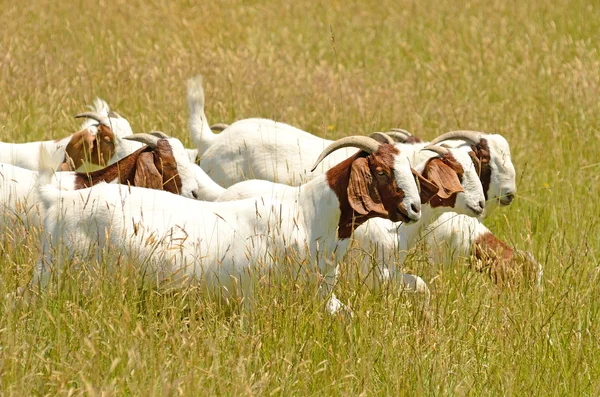
The Boer goats are from South Africa. It is a medium-sized goat breed reared for meat. They are common in Laikipia and Nakuru counties and among small-holder farmers in Central Kenya. Their color is mostly a white body with a red head and neck. But, they can be all white or all red.
What makes the Boers the best goat breed for meat in Kenya? According to studies. the Boer goat has the following characteristics.
- Boer goats were developed by Dutch farmers in South Africa in the early 1900s, known for their rapid growth rate, excellent carcass qualities, and adaptability to different environments
- They are known for their high growth rates, and good body conformation, and are considered the ideal meat goat breed due to their rapid growth and meaty carcass
- They are known for their large body size, with adult bucks reaching 150 kg. The female boer can reach up to 100 kg, making them impressive in size and stature
- Boer goats are polyestrous, reaching sexual maturity at five months of age, and are known for multiple births and achieving a 200% kid crop in managed herds
- Common crosses include Boer x Spanish goat, Boer x Angora goat, Boer x Nubian goat, and other breeds for specific breeding purposes
Dairy Goat Breeds in Kenya
Milk goats are bred primarily for milk production, providing high-quality milk with unique taste and health benefits for human consumption. They have a long-legged conformation to accommodate large milk-filled udders without damage, making them suitable for high milk yields.
Alpine
The Kenya Alpine goat is a medium dairy breed. It is reared under hybrid or zero-grazing production systems.
The alpine goad originated from the Alps mountain regions of France, Switzerland, and Germany. In Kenya, it is a popular dairy goat in high rainfall areas of central (Nyeri, Murang’a, Kirinyaga, Embu, Nakuru, Kiambu, and Meru) and western (Vihiga) Kenya.
Kenya Alpine Goat Characteristics
- Birth weight; 2.0-3.5kg
- Weaning weight; 15-18kg
- Weaning age: 3-4 months
- Mature weight doe; 50-60 kg
- Mature weight buck; 70-76 kg
- Average milk daily yield; 2.5-4.0 l/day
- Age of doe at first kidding; 18-24 months
- Height at withers: 70-76cm (doe) and 80-90cm( buck)
- Coat hair: short on the body but long on the chest, thighs, and mane.
- Coat color: brown with shades of grey, or black and a black topline
Saanen Goat
Saanen is one of the large dairy goat breeds in Kenya. It was introduced from Germany in the 1990s by the Heifer International. Due to its high milk production, Saanen has heavily been crossbred with other dairy goats.
Saanen is best reared under intensive and semi-intensive production systems. Since they are photosensitive, it is better if you rear them in a goat shed or shelter.
Saanen Goat characteristics
- Birth weight; 2-3kg
- Weaning weight;15-20kg
- Mature weight doe; 50-70 kg
- Mature weight buck; 70-100 kg
- Average milk daily yield; 3-5 l/day
- Age of doe at first kidding; 18-20 months
- Height at withers: 81-92cm (doe) and 74-80cm( buck)
- Coat hair: short fine and smooth.
- Coat color: white or cream
Toggenburg goat
The Toggenburg is a dairy goat that is an indigenous breed in Switzerland. In Kenya, it was introduced in 1996 by Farm Africa. The breed is mostly found in Meru, Tharaka-Nithi, Kitui, and Makueni Counties. Considerable numbers are also found in Nakuru, Kiambu, and Nairobi Counties.
The goat breed is of a good temperament. You can raise it under either intensive or semi-intensive production systems.
Toggenburg goat characteristics
- Birth weight; 2.2-2.5kg
- Weaning weight;15-18kg
- Mature weight doe; 50-60kg
- Mature weight buck; 65-70kg
- Average milk daily yield; 1-3 l/day
- Age of doe at first kidding; 18-20 months
- Height at withers: 74-80 cm (doe) and 81-92 cm( buck)
- Coat hair: short (females) fine and smooth.
- Coat color: Brown or greyish brown with distinct white stripes on the face and legs
Oberhasil goat

The Obehasil goat is famed as one of the best dairy goat breeds in the world. It is native to the Switzerland Mountains. In Kenya, it is reared for milk production or hobby purposes.
It is a medium-sized breed. Its primary color is Chamois or Bey; light to deep red. It’s mainly reared under semi-intensive production system.
Characteristics and features of Oberhasil goats
- Chamoisee color pattern: deep reddish bay coat broken by black markings on the muzzle, forehead, back, belly, and legs below the knees
- Average milk yield around 1650 pounds (750 kg) over 265 days
- Fine, sweet-flavored milk suitable for fresh chèvre cheeses and other dairy products
- Bucks: 30 to 34 inches (75-85 cm) in height, can weigh up to 150 pounds (65-75 kg in Europe)
- Does: 28 to 32 inches (70-80 cm) in height, can weigh up to 120 pounds (45-55 kg in Europe)
- Reliable milk production with sweet, rich milk and butterfat content around 3.4%
- Require regular deworming, hoof trimming, and access to mineral supplements
Multi-Purpose Goats in Kenya
While there are attempts to create dual-purpose goats that can produce both meat and milk, successful dual-purpose breeds are rare.
Anglo Nubian

Anglo-Nubian is a crossbreed of native British goats and several goats from India, the Middle East, and North Africa. It is a dual-purpose goat that is used in cross-breeding programs in Kenya. Its crossbreds have increased milk and meat production than the indigenous goats. Besides, its offspring with exotic dairy goats improve the butter fat content in milk.
Anglo-Nubian goat characteristics
It is commonly reared in Kenya under an extensive production system. It is well adapted to harsh hot climates. Its milk has the highest butter fat content of 4-5%. Its protein content ranges from 3.8-4.5%.
- Birth weight; 2.2-2.5kg
- Weaning weight;15-18kg
- Mature weight doe; 25-35kg
- Mature weight buck; 30-40kg
- Average milk for lactation period; 2000-5000 L in 305 days.
- Age of doe at first kidding; 21-27months
- Height at withers: 130-150 cm
- Coat hair: shiny, fine and smooth.
- Coat color: Mostly light brown, grey, or dull black.
Which is the cheapest goat farming method in Kenya?
Kenya has 3 goat farming methods; zero grazing, pastoralism, and semi-intensive.
- Intensive production system or zero grazing. You will house the goats and provide them with water and fodder. It’s common for dairy goat farming in Kenyan highlands and urban areas where land sizes are small. It has the highest feeding expenses.
- The extensive goat-rearing system or pastoralism. It involves grazing animals in the natural pastures. It’s common for goat meat farming in Semi-Arid areas. It requires large land with suitable vegetation forage. It is the cheapest method with the key cost being labor.
- Semi-intensive goat farming is a hybrid of both intensive and extensive systems. The goats are left to graze in the open and are provided with feed, water, and housing.
To select the best method to raise your goats, consider the available land size, farming goals, and other resources such as money. Whichever method you adopt, your goats should have access to a balanced diet. This should be a mixture of quality forage, concentrated feed, water, and minerals throughout the day.
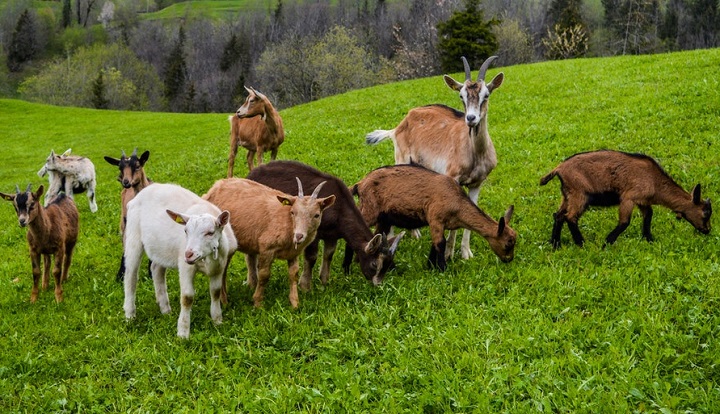
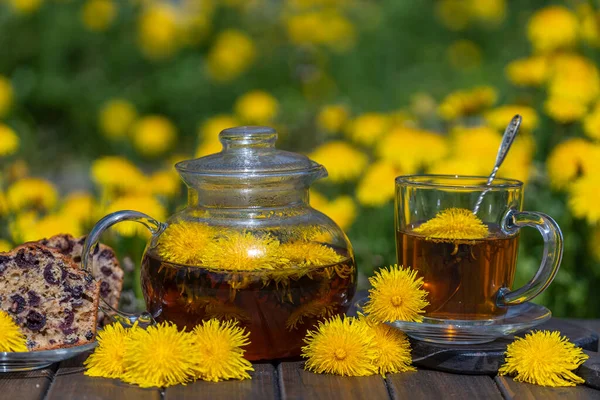
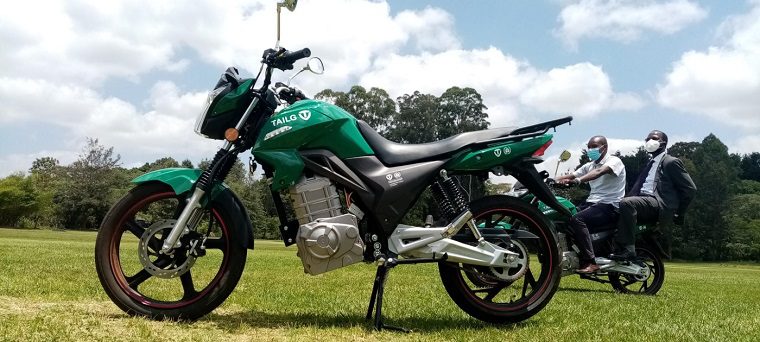
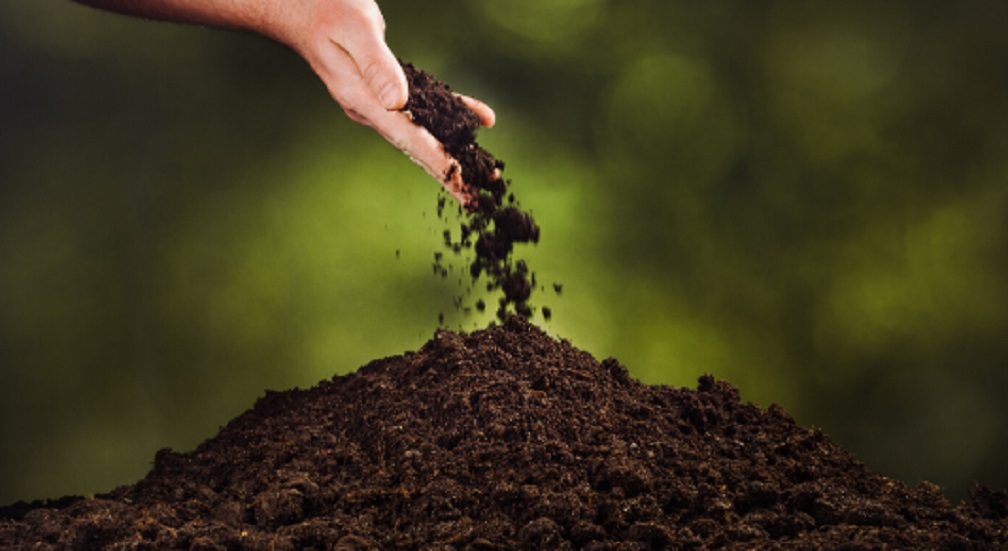
Am really impressed by your definition and explanation of the types of goat